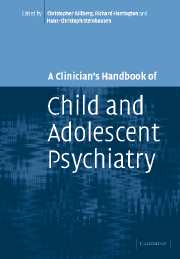Book contents
- Frontmatter
- Contents
- Preface
- List of contributors
- 1 Brain disorders
- 2 Substance use disorders
- 3 Schizophrenia and schizophrenia-like disorders
- 4 Affective disorders
- 5 Anxiety disorders
- 6 Obsessive-compulsive disorders
- 7 Adjustment disorders
- 8 Post-traumatic stress disorder
- 9 Functional somatic symptoms and somatoform disorders in children
- 10 Eating disorders: anorexia nervosa and bulimia nervosa
- 11 Sleep disorders
- 12 Personality disorders
- 13 Mental retardation/learning disability
- 14 Specific developmental disorders of speech and language
- 15 Reading and other learning disorders
- 16 Autism spectrum disorders
- 17 Hyperkinetic disorders
- 18 Conduct disorders
- 19 Elective mutism
- 20 Attachment and disorders of attachment
- 21 Tic disorders
- 22 Elimination disorders: enuresis and encopresis
- 23 Physical and sexual abuse
- 24 Gender identity disorders
- Index
- References
7 - Adjustment disorders
Published online by Cambridge University Press: 06 August 2009
- Frontmatter
- Contents
- Preface
- List of contributors
- 1 Brain disorders
- 2 Substance use disorders
- 3 Schizophrenia and schizophrenia-like disorders
- 4 Affective disorders
- 5 Anxiety disorders
- 6 Obsessive-compulsive disorders
- 7 Adjustment disorders
- 8 Post-traumatic stress disorder
- 9 Functional somatic symptoms and somatoform disorders in children
- 10 Eating disorders: anorexia nervosa and bulimia nervosa
- 11 Sleep disorders
- 12 Personality disorders
- 13 Mental retardation/learning disability
- 14 Specific developmental disorders of speech and language
- 15 Reading and other learning disorders
- 16 Autism spectrum disorders
- 17 Hyperkinetic disorders
- 18 Conduct disorders
- 19 Elective mutism
- 20 Attachment and disorders of attachment
- 21 Tic disorders
- 22 Elimination disorders: enuresis and encopresis
- 23 Physical and sexual abuse
- 24 Gender identity disorders
- Index
- References
Summary
Introduction
The concept of adjustment disorder (or a group of adjustment disorders) has a long history, though what is actually meant by the term has changed over time. Originally, as ‘adjustment reaction’, it was one of a very few disorder categories included in major psychiatric classification schemes specifically for use in children and adolescents. In DSM-I, for instance, adjustment reaction and childhood schizophrenia were the only two categories of childhood psychiatric disorder. The intention was to indicate that some instances of disordered behaviour or emotions arose specifically because of an identified stressor rather than, say, a process of mental illness. The source of stress was originally thought of as including both external events (such as bereavement) or an internal developmental process, which might require significant adaptation of mental functioning (such as maturational changes during adolescence). There was an implicit idea that adjustment to adversity or intra-psychic conflict could be either adaptive or maladaptive. If it was maladaptive, then personal dysfunction was to be seen as a psychiatric condition.
Historically, the most widespread way of understanding a psychological response to adversity or conflict was initially through psychoanalytic theory and a concept of trauma or intrapsychic conflict secondary to external events or developmental challenges. Subsequently, the development of a model of social influences led to a rather different way of thinking which emphasized processes rather more than events.
- Type
- Chapter
- Information
- A Clinician's Handbook of Child and Adolescent Psychiatry , pp. 207 - 220Publisher: Cambridge University PressPrint publication year: 2006
References
- 3
- Cited by



